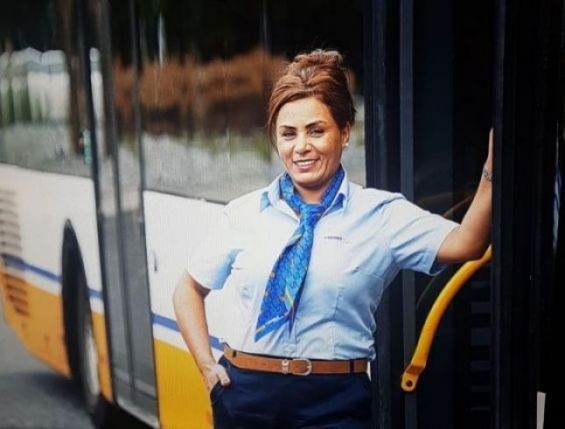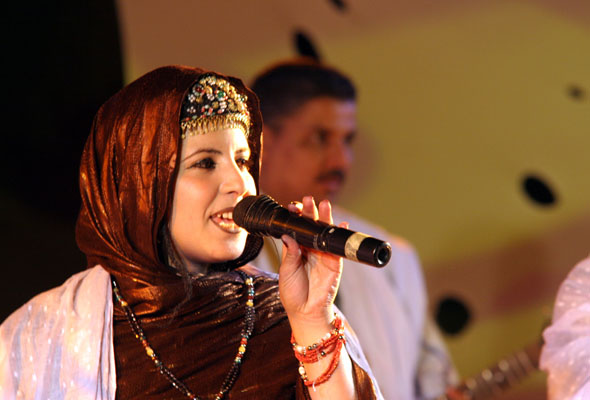The eldest of her siblings and the daughter of a retired member of the Royal Armed Forces, Hakima Ouamira lived most of her life far from her native village Larbaa Oukabli (Azilal province). When she arrived in Germany, she was inspired by the alleys of her childhood, the fascinating universe of the souks and the region of Beni Mellal, where she also lived with her family, to make her first paintings.
After graduating highschool in Morocco, Hakima Ouamira seized the first opportunity to come her way to discover a new social and cultural environment. «I always liked traveling with my parents when I was a child. So I went to Germany for my love of discovery and I worked there at the same time as a baby-sitter, with a visa which was only valid for one year», she told Yabiladi.
From painting to art therapy
Hakima Ouamira showed a great interest for learning anything new to her, starting with the German language and culture. But that didn't make homesickness go away easily. During her first months in Germany her «heart and soul were still in Morocco». When she was not babysitting, she would find artistic occupations, which allowed her to escape and reconnect with her native country. «I decided to buy paint to draw in my spare time and found that it made me feel fulfilled», she recalled.

Hakima quickly faced health problems, which required a long recovery period. Between healing and being away from family, drawing was the only escape. By drawing landscapes from her childhood memories, «the weight of all these problems disappeared». A self-taught artist, she improved her paintings until she became known in the local modern abstract art scene, as the initiator of a particular washing technique.
Her close circle to her pushed her to meet with professionals in the German art scene, to show them her work and talk to them. This is how an informal meeting changed the course of her life.
«A friend introduced me to a painter, who had been teaching plastic arts at the university for 14 years.I showed her my drawings, which she really liked.She was even more touched to know that these were creations of an autodidact, then she encouraged me to take drawing lessons and workshops with a colleague of hers and an artist».
For Hakima Ouamira, drawing and painting feel like therapy. Thanks to her progress and the observations of her painter friends, she developed her own style even more and devoted herself to art in a professional manner, starting from 2008. Her two artistic encounters have allowed her to participate in group and individual exhibitions, before starting to teach her technique at the People's University (Volkshochschule) in Darmstadt.
An artsy bus driver
But Hakima Ouarmira did not devote herself solely to painting. In the morning, she is one of the very few women driving Darmstadt city buses. In the afternoon, she swaps her conductor's outfit for that of a drawing teacher.
«It is a feeling of pride for me because today, nothing is impossible for women, including jobs which have been exclusively or mainly for men», she said.

«Even in an egalitarian society, driving a bus is still very inaccessible to women. But people are proud to see us behind the wheel and encourage us a lot. Many passengers congratulate us on it», she explained.
As a child who loved traveling, Hakima had long wondered why women were so little present in the public transport jobs. «When I was little, we used to travel a lot on coaches and I only saw men driving. It stuck in my mind that one day I had to drive a public transport vehicle, be it a plane, train, bus or taxi!», she recalled.
Once in Germany, Hakima Ouamira was a frequent bus commuter. «In the company where I work, there were 240 drivers, of which only 6 were women. As I went along, I naturally found myself, one day, applying for the job», she proudly recalled. For her, this work makes it possible to innovate differently in plastic art.
«When you spend 8 hours a day driving a bus, you come into contact with people from different backgrounds and different cultures. You get to discover urban landscapes in another way, expanding imagination and creativity.Contrary to popular belief, these two professions are closely linked because, by opening up to a variety of socio-cultural backgrounds, creative barriers are erased».
In this eclectic universe, Hakima fits in, without fading away. «We have to reconcile the two, on the one hand so as not to become alienated by forgetting where I come from and on the other hand, so as not to be detached from a social fabric that has included us and of which we are part», she stressed.
An artistic baptism in Morocco
Far from being an obstacle, this dual culture has opened up professional exhibition spaces in Germany for Hakima, where the originality of her drawing techniques has distinguished her. «The Moroccan-German association for culture and integration also facilitated this access for me and it was not difficult to reach the public, in all the cities where I have exhibited so far», she said. «I am happy with the interest of visitors in my work and the exchange is always informative with them, because they want to know more», she explained.
.jpg)
Her 15-year-old son also takes part to the lifestyle. «During my exhibition held in Düsseldorf in 2014, he also showed his paintings and the funds raised were sent to an association for children with disabilities in Casablanca», she recalled.
While individual exhibitions greatly contribute to showing broad aspects of the artistic work of a painter, Hakima appreciates collective events, which make it possible to «create a synergy with all the artists and to learn a lot from the various artistic schools».
It is in this context that her works will be shown for the first time in Morocco, through «The Wall», from November 9 at the Espace Rivages in Rabat, along with those of her colleague Mohammed Ouammi. «My great pride is to participate in an artistic exhibition in my country of origin, which allows me to strengthen ties and to 'come home' differently», she said, two days before the opening of the event.





 chargement...
chargement...













